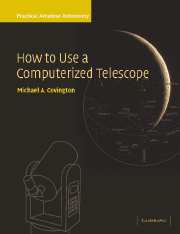11 - Celestron NexStar 5 and 8
Published online by Cambridge University Press: 10 February 2010
Summary
Introduction
Although it came on the market slightly later than the Meade Autostar, the original model Celestron NexStar is a simpler design, so it is logical to describe it first.
This chapter is based on my experiences with a NexStar 5 purchased in 2001. This is a 5-inch (12.5-cm) Schmidt–Cassegrain and was initially the flagship of the NexStar fleet. It is practically identical to the original (one-armed) NexStar 8.
Related products
Celestron has subsequently introduced a wide range of NexStar telescopes, ranging from small refractors to an 11-inch Schmidt–Cassegrain. Some of the smaller NexStars have been sold under the Tasco Starguide label.
No two NexStar models have entirely the same firmware, and the product line is still evolving rapidly. Accordingly, this description of the NexStar 5 will serve only as a general guide to the rest of the product line; changes are ongoing. Many different versions of the NexStar 5 firmware are already extant.
The top-of-the-line NexStar GPS telescopes are radically different and are not covered here. They include GPS receivers to determine the latitude, longitude, and time; periodic-error correction; and other advanced features.
Evaluation of the NexStar 5
Compared with Meade LX200 and Autostar telescopes, the NexStar 5 is appreciably easier to use because it has fewer features; the overall design of the firmware is simpler. The optics are from the classic (and, in my opinion, underrated) Celestron 5.
- Type
- Chapter
- Information
- How to Use a Computerized TelescopePractical Amateur Astronomy Volume 1, pp. 169 - 192Publisher: Cambridge University PressPrint publication year: 2002

